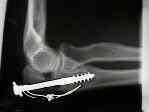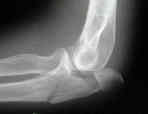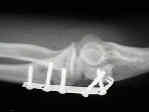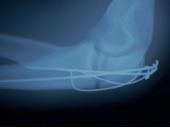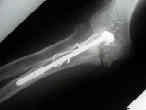Skip to content
Discussion
- transverse frx involving less than 50% of proximal sigmoid notch are suited to stable internal fixation by tension band;
- Weber modification provides improved frx rigidity;
- may also use T.B.W. along with a 6.5 mm cancellous screw, 7.0 mm screws, or 7.3 mm screw;
- surgical consent: patient should understand, the the hardware can causeolecranon bursitis, which will require future hardware removal;
Fracture Reduction
- performed w/ elbow in extension which relaxes pull of triceps muscle;
- begin by drilling a superficial hole in the distal fragment to allow introduction of the tip of the pointed reduction forceps;
- other tip of forceps catches proximal fragment & reduces fracture;
- lag screw: stabilization of oblique frx w/ lag screw before tension band wiring will improves stability;
Tension Band Wiring
- wire for the tension band should be 1.0 to 1.2 mm in diameter (or 18 gauge);
- distally, wire for tension band is inserted thru 2.0 mm drill hole which is distally located, approximately same distance
- from frx as tip of olecranon (which is usually 3-4 cm distal to frx site);
- some authors advocate placement of the distal hole ulnar to the central longitudinal axis, noting that this helps to compress the articular surface;
- this distance is necessary to maximize tension band effect;
- drill hole must be deep to the subQ cortex of the ulna (at least 3 mm), since it may cut out if it is placed too superficially;
- proximally, tension band wire must pass deep to triceps tendon (on periosteum of the olecranon) & be just proximal to the 6.5 mm screw (or K wires);
- use 14 gauge angiocath to facilitates passage beneath triceps;
- if the wire is run deep to the triceps tendon without the support of the K wires, there is a risk of triceps tendon necrosis & rupture
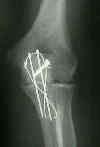
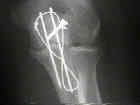
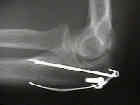
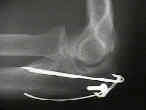
Screw Technique
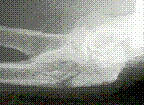
- depending on the size of the patient, may use 6.5 mm screw, 7.0 mm screw, or 7.3 mm screw;
- cancellous screw plus tension band wire in combination provides greater strength of fixation than K wire and tension band technique;
- preop planning:
- select partially threaded screw w/ 32 mm of distal threads;
- in small ulna, the screw thread may not pass into meduallary cavity of shaft and a long 6.5 mm screw may jam before it achieves a good bite;
- 1 cm longitudinal incision is made in the midline of the triceps;
- 4.5 mm drill is used to make glide hole in proximal frx fragment;
- be sure that frx reduction has not been lost;
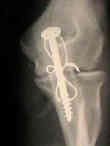
- golf tee is inserted, and 3.2 mm drill is inserted across distal fragment;
- 6.5 mm tap is inserted across the frx site;
- some authors recommend stopping the tap once it meets firm torsional resistance (which marks the appropriate screw length);
- other authors recommend inserting the screw 8-10 cm, but excessively long screws can bend, making retrieval difficult;
- 6.5 mm screw is inserted over washer, and incompletely tightened (to allow of tensioned wire);
Technique of Wire Tightening
- before tightening the figure of eight wire, two loops should be made, which allows more even tightening on both sides of fracture;
- prior to tightening, make sure that wires are straightened out & pulled very tight before it is placed under tension by twisting;
- consider using the "Jet" or "Harris" wire tightener;
- tension band should be tightened in full extension to cause slight overreduction of frx, which disappears as elbow is flexed;
- ensure that frx site does not collapse or shift;
- wire loops are tightened by pulling, and the slack taken by twisting;
- trying to tighten wire by twisting results in an asymmetrical spiral with the danger of wire breakage;
- wires must be straightened first and then pulled and twisted at the same time to avoid failure;
- after the wires have been tightened, the ends are cut off slightly long, and are bent into the bone w/ needle nose pliers;
Complications
- loss of fixation and nonunion;
- occurs most often in olecranon fractures which occur along the distal half of the sigmoid notch;
- in this case, an olecranon nonunion was treated w/ a one third tubular hook plate
